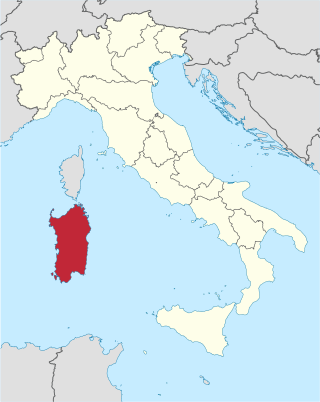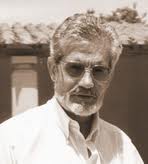Related Research Articles

Sardinian or Sard is a Romance language spoken by the Sardinians on the Western Mediterranean island of Sardinia.

Sardinia is the second-largest island in the Mediterranean Sea, after Sicily, and one of the twenty regions of Italy. It is located west of the Italian Peninsula, north of Tunisia and immediately south of the French island of Corsica.
Sardinia is probably the most culturally distinct of all the regions in Italy and, musically, is best known for the tenore polyphonic singing, sacred chants called gosos, the launeddas, an ancient instrument that consists of a set of three single-reed pipes, all three mouth-blown simultaneously using circular breathing, with two chanters and one drone and the cantu a chiterra, a monodic song that is accompanied by guitar, widespread mainly in the center and north of the island.

The flag of Sardinia, called the flag of the Four Moors or simply the Four Moors, represents and symbolizes the island of Sardinia (Italy) and its people. It was also the historical flag and coat of arms of the Aragonese, then Spanish, and later Savoyard Kingdom of Sardinia. It was first officially adopted by the autonomous region in 1950 with a revision in 1999, describing it as a "white field with a red cross and a bandaged Moor's head facing away from the hoist in each quarter".
Pier Michele Giagaraccio was a jurist, lawyer, and poet from Sardinia. He flourished in sixteenth century Sassari.

The Sardinians, or Sards, are a Romance language-speaking ethnic group native to Sardinia, from which the western Mediterranean island and autonomous region of Italy derives its name.

The Perfect Fusion was the 1847 act of the Savoyard King Charles Albert of Sardinia which abolished the administrative differences between the mainland states and the island of Sardinia within the Kingdom of Sardinia, in a fashion similar to the Nueva Planta decrees between the Crown of Castile and the realms of the Crown of Aragon between 1707 and 1716 and the Acts of Union between Great Britain and Ireland in 1800.
Nicola Tanda was an Italian philologist and literary critic. He studied under Ungaretti and Sapegno at Rome. He was for over thirty years professor at the University of Sassari, first specialising in Italian literature, and then later in Sardinian philology and Sardinian literature. He was a leading advocate for minority languages and their literary expression in the island of Sardinia, including the Sardinian language and Algherese Catalan. As such he was an honorary member of ANPOSDI. He wrote the new Philology of Italians based on the European Charter for Regional or Minority Languages. He was founder and president of the Sardinian PEN Club. He was president of the jury of the Premio Ozieri literary prize founded in 1956 to promote new works composed in Sardinian tongues. He founded in 2003 the Centre for Study of Sardinian Philology. As an editor/director he has guided the publication of over 100 volumes written in Sardinian languages.

A condaghe, from the medieval Sardinian term kondake, was a kind of administrative document used in the Sardinian judicates between the 11th and 13th centuries. They are one of the earliest witnesses for the development of the Sardinian language and are an important source for historians of medieval Sardinia.

Sardinian nationalism or also Sardism is a social, cultural and political movement in Sardinia calling for the self-determination of the Sardinian people in a context of national devolution, further autonomy in Italy, or even outright independence from the latter. It also promotes the protection of the island's environment and the preservation of its cultural heritage.

Giulio Angioni was an Italian writer and anthropologist.
Giovanni Lilliu, was a renowned archeologist, academician, publicist and politician and public figure and an expert of the Nuragic civilization. Largely due to his scientific and archeologic work in the Su Nuraxi di Barumini in Sardinia, Italy, the site was inscribed on the UNESCO list of World Heritage Sites in 1997.

The literature of Sardinia is the literary production of Sardinian authors, as well as the literary production generally referring to Sardinia as an argument, written in various languages.
This article presents a history of Cagliari, an Italian municipality and the capital city of the island of Sardinia. The city has been continuously inhabited since at least the neo-lithic period. Due to its strategic location in the Mediterranean and natural harbor, the city was prized and highly sought after by a number of Mediterranean empires and cultures.
Sardinian Literary Spring is a definition of the whole body of the literature produced in Sardinia from around the 1980s onwards.

Hampsicora was a Sardo-Punic political leader and landowner of Sardinia, and the leader of the major anti-Roman revolt in the province of 215 BC.

Sardinia's Day, also known as Sardinian people's Day, is a holiday in Sardinia commemorating the Sardinian Vespers occurring in 1794–96.

S'hymnu sardu nationale, also known by its incipit as Cunservet Deus su Re, was the national anthem of the Kingdom of Sardinia under Savoyard rule and of the Kingdom of Italy.

Sardinian surnames are surnames with origins from the Sardinian language or a long, identifiable tradition on the Western Mediterranean island of Sardinia.
Francesco Cesare Casula is a Sardinian historian from Italy.
References
- 1 2 "Sa vida, su martiriu, et morte dessos gloriosos martires Gauinu, Brothu et Gianuari, Hieronimu Araolla" (PDF). Archived from the original (PDF) on 2018-12-15. Retrieved 2018-12-13.
- 1 2 Rimas Diversas Spirituales de Su Dottore Hieronimu Araolla Sardu Sassaresu, Hieronimu Araolla
- ↑ Francesco Cherubini, Carlo Clausen (1902)